Click on the map below to learn more

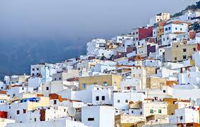 |
Tangier, MoroccoLocated at the western edge of the Strait of Gibraltar, Tangier is the second largest city in Morocco with a population 1.8 million. It was once a haven and popular vacation spot for famous artists and writers such as Tennessee Williams and George Orwell, who were attracted to the cities multicultural influences. It was also known as a headquarters for international spies. Today, tourism persists as the city's main industry. Tangier has also served as the setting for numerous movies as well as the subject of many popular novels. |
| Back to Map | |
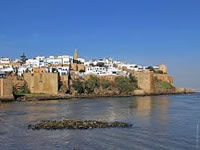 |
Rabat, MoroccoRabat is the capital and second-largest city of Morocco. It has a population of about 620,000. Rabat is a popular tourist destination and its location on the Atlantic Ocean makes it easily accessible. Construction, textiles, and food processing are the city's most important economic engines. Like many north African cities, Rabat was an important port once controlled by the Barbary Pirates, the naval branch of the Ottoman Empire. The infamous pirates demanded tributes (payments) from foreign nations to ensure such nations had free navigation of the Mediterranean Sea. Sails from nations that did not pay were subject to being kidnapped, tortured or enslaved. The Barbary Pirates were finally defeated by the US Navy in 1811..the first foreign war fought by the United States. |
| Back to Map | |
 |
Casablanca, MoroccoCasablanca is the largest city in Morocco and one of the most famous and important cities in all of Africa. with a population four million, Casablanca is the economic and cultural hub or Morocco. Furthermore, Casablanca is the largest port city in north Africa and serves as the headquarters of the Royal Moroccan Navy. The name Casablanca means "white house" in Spanish, but the city's name was actually derived from Portuguese. Many local citizens simply call it "casa." Casablanca is home to one of the world's largest mosques (7th largest) known as Hassan II Mosque, which can hold 25,000 worshipers and an additional 80,000 in its courtyard. The minaret is 60 stories high and is equipped at the top with a laser, the light of which is directed toward Mecca. |
| Back to Map | |
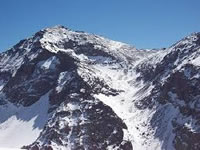 |
ToubkalRising to a height of 13,671, Toubkal is the highest peak in Morocco and the highest peak in north Africa. Toubkal is a popular destination for mountain climbers and is considered a difficult climb. |
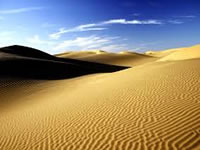 |
Sahara DesertCovering 3.6 million square miles, the Sahara Desert is the world's largest non-polar desert. It is also the world's hottest and sunniest desert. Covering most of north Africa, the Sahara Desert is roughly the size of the entire United States. Windswept sand dunes in the desert can reach heights of nearly 600 feet. Parts of the Sahara Desert can go decades without receiving any rainfall. With some rare rainfall in the Sahara, the raindrops can evaporate before hitting the sandy surface.
|
| Back to Map | |
 |
Atlas MountainsThe Atlas is a mountain range extending about 1,600 miles through Tunisia, Algeria, and Morocco. The Range separates the Mediterranean and Atlantic coastlines from the Sahara Desert. The highest peak in the range is called Toubkal (in Morocco), which rise 13,665 feet.
|
| Back to Map | |
| Population: | 33,250,000 (2014) |
| Area: | 172,487 sq. miles |
| Capital City: | Rabat |
| Largest City: | Casablanca |
| Currency: | Morrocan dirham |
| Official Language: | Arabic |
| GDP (Gross Domestic Product) | $189.1 Billion |
- Morocco is one of only three countries to have both a Mediterranean and Atlantic coastlines.
- The Strait of Gibraltar is an 8.9 mile-across waterway that separates Africa (at Morocco) from Europe (at Spain). Boats can travel at these points between Africa and Europe in less than 35 minutes.
- Toubkal, located in Morocco's Atlas Mountains, is the highest peak in north Africa.
- Morocco annexed neighboring Western Sahara (still in dispute) in 1975 and refers to it as its Southern Provinces.
- The now extinct Barbary Lion once roamed the Atlas Mountains of Morocco and remains a national symbol.
- The ski resort town of Ifrane recorded the lowest temperature ever measured in Africa at -11 degrees Fahrenheit in 1935.
- 45% of Moroccans work in agriculture related jobs.
- Morocco is the world's third-largest producer of Phosphorus
- Tourism is Morocco's second most important industry (after Phosphorus). The nation hosted more than 10 million tourists in 2013.
- Plunging 360 feet into a river valley surrounded by thousands of waterfalls, Ouzoud Falls, near the city of Marrakesh, is the highest waterfall in north Africa, and one of the most popular and visually stunning tourist attractions in Morocco.
|
|
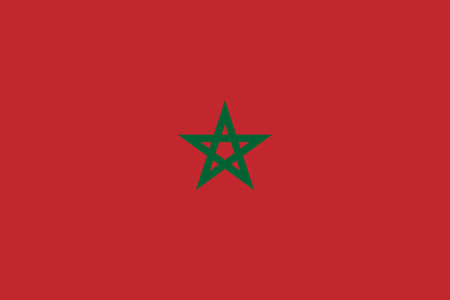 |
|
| The red and green colors of the Moroccan flag represent Islam. Red also represents the color of the current dynasty and the green star (the Seal of Solomon) represents the links between God and the nation of Morocco. | |